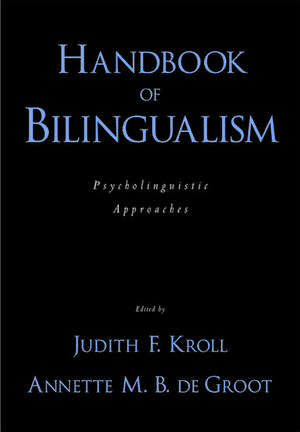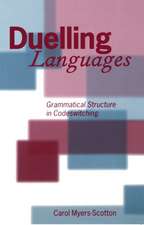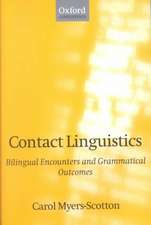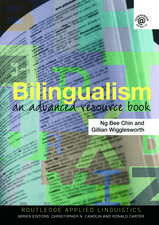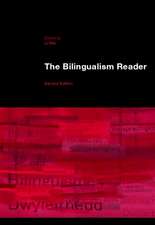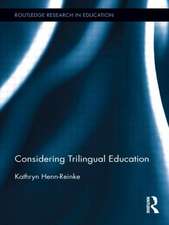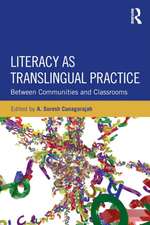Handbook of Bilingualism: Psycholinguistic Approaches
Editat de Judith F. Kroll, Annette M. B. De Grooten Limba Engleză Paperback – 30 apr 2009
| Toate formatele și edițiile | Preț | Express |
|---|---|---|
| Paperback (1) | 369.06 lei 31-37 zile | |
| Oxford University Press – 30 apr 2009 | 369.06 lei 31-37 zile | |
| Hardback (1) | 669.93 lei 31-37 zile | |
| Oxford University Press – 23 iun 2005 | 669.93 lei 31-37 zile |
Preț: 369.06 lei
Preț vechi: 526.45 lei
-30% Nou
Puncte Express: 554
Preț estimativ în valută:
70.62€ • 73.92$ • 58.78£
70.62€ • 73.92$ • 58.78£
Carte tipărită la comandă
Livrare economică 20-26 martie
Preluare comenzi: 021 569.72.76
Specificații
ISBN-13: 9780195373653
ISBN-10: 0195373650
Pagini: 608
Dimensiuni: 251 x 178 x 46 mm
Greutate: 1.05 kg
Editura: Oxford University Press
Colecția OUP USA
Locul publicării:New York, United States
ISBN-10: 0195373650
Pagini: 608
Dimensiuni: 251 x 178 x 46 mm
Greutate: 1.05 kg
Editura: Oxford University Press
Colecția OUP USA
Locul publicării:New York, United States
Recenzii
Without a doubt, this book will become the primary textbook for graduate courses in psycholinguistics. It is likely to end up on the required reading list for most active researchers with an interest in psycholinguistics specifically and in cognitive science in general.
This volume presents a thorough coverage of the entire field of psycholinguistic research on bilingualism, from lexical access to functional neuroimaging. All the articles are by experts in their area and were written expressly for this volume. It is hard to imagine a better or more useful contribution to the field.
This very first handbook on bilingualism will be an indispensable beacon and a source of inspiration for all students of the bilingual mind. The editors created a transparent and coherent framework for the worlds experts to review the booming psycholinguistics and cognitive neuroscience of bilingual acquisition, comprehension and production.
The Handbook of Bilingualism is essential reading for anyone interested in questions about learning and using a second language. It addresses all the classic questions and raises new ones that have begun to be answered with new methods of brain imaging. The editors of this handbook are both outstanding investigators, and the 26 chapters provide a comprehensive review of theories and experimental studies of bilingualism. The book is beautifully written, in many cases in an authors second language. As islands of monolingualism such as those in parts of the United States increasingly give way to the bilingualism and multilingualism of most people in the world, a scientific understanding of the nature of bilingualism and the ways a second language is acquired becomes even more important. This handbook is a comprehensive resource for that enterprise. I recommend it with the greatest enthusiasm.
Kroll and de Groot have been two of the most prolific and influential researchers in the psycholinguistic investigation of bilingualism. In this book, they have brought together a truly impressive group of researchers. As the editors note, studies of bilingualism from a cognitive-science perspective have exploded in the last decade, as scientists have come to appreciate how normal bilingual language use is. Thus, the cutting-edge work presented in this collection should be of great interest to anyone who is looking for a better understanding of human language, and of cognition more broadly.
This volume presents a thorough coverage of the entire field of psycholinguistic research on bilingualism, from lexical access to functional neuroimaging. All the articles are by experts in their area and were written expressly for this volume. It is hard to imagine a better or more useful contribution to the field.
This very first handbook on bilingualism will be an indispensable beacon and a source of inspiration for all students of the bilingual mind. The editors created a transparent and coherent framework for the worlds experts to review the booming psycholinguistics and cognitive neuroscience of bilingual acquisition, comprehension and production.
The Handbook of Bilingualism is essential reading for anyone interested in questions about learning and using a second language. It addresses all the classic questions and raises new ones that have begun to be answered with new methods of brain imaging. The editors of this handbook are both outstanding investigators, and the 26 chapters provide a comprehensive review of theories and experimental studies of bilingualism. The book is beautifully written, in many cases in an authors second language. As islands of monolingualism such as those in parts of the United States increasingly give way to the bilingualism and multilingualism of most people in the world, a scientific understanding of the nature of bilingualism and the ways a second language is acquired becomes even more important. This handbook is a comprehensive resource for that enterprise. I recommend it with the greatest enthusiasm.
Kroll and de Groot have been two of the most prolific and influential researchers in the psycholinguistic investigation of bilingualism. In this book, they have brought together a truly impressive group of researchers. As the editors note, studies of bilingualism from a cognitive-science perspective have exploded in the last decade, as scientists have come to appreciate how normal bilingual language use is. Thus, the cutting-edge work presented in this collection should be of great interest to anyone who is looking for a better understanding of human language, and of cognition more broadly.
